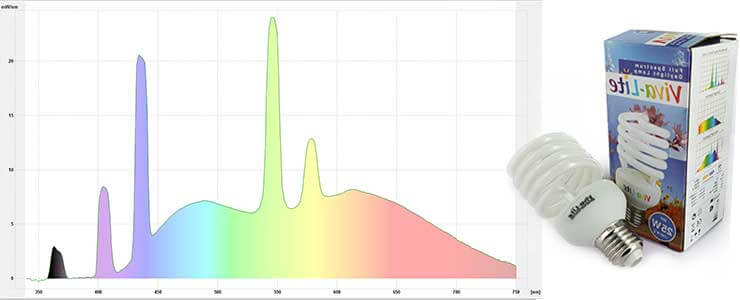The Colour Rendering Index CRI is the ability of a light source to reproduce all the colour nuances of the object it illuminates.
The luminous flux of LED lamps or luminaires is measured using an integrating sphere.
This sphere measures the total quantity of lumens emitted by the source under test, compared with a calibrated lamp.
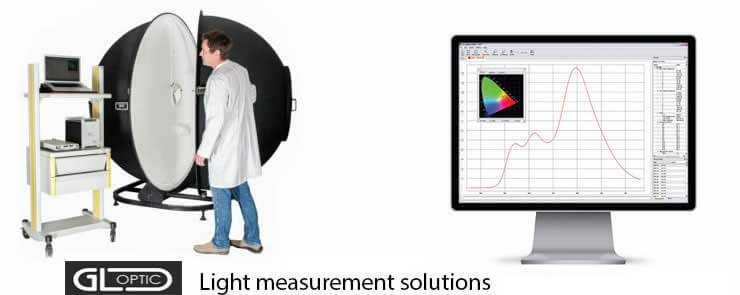
All too often there is confusion between colour temperature and colour rendering index.
A spectrum considered to be ideal is the case with the luminosity of the sun, which has a CRI close to 100 ra at midday and 89.8 ra for this sunset, captured at a colour temperature of 3849 Kelvin.

Sunset with a colour temperature of 3849 K and a colour rendering index of 89.8 ra
In this case we're talking about a full spectrum, i.e. the luminosity delivered by the sun at midday.
Although the colour visible to the human eye is a slightly warm white, an in-depth analysis of this luminous flux will reveal that there is a full spectrum of colours, from violet to blue, passing through green, yellow and ending with orange and red.
At either end of the spectrum are the infrared and ultraviolet colours that we cannot perceive.
The combination of all these colours in greater or lesser quantities for each of them generates a natural colour temperature ranging from a bright white in the morning to a slightly warm white for midday sunlight colours of around 4,000 Kelvin and 3,849 Kelvin or more for sunset.
With an artificial lighting source, you can produce a colour with a lighting temperature that is virtually identical, for example with an RGB matrix LED bulb that you can adjust with your remote control to a Kelvin value that is more or less the same as the sunset.
The colourimetry obtained by combining the three primary monochromatic colourLEDs - red, green and blue - at a specific power setting for each of them enabled us to easily obtain a colour temperature of 3639 Kelvin, a value close to that of the sunset.
However, analysis of the light spectrum revealed three major colour peaks: red, green and blue. In this case, we're talking about a poor light spectrum with a mediocre CRI of 17.0 ra.
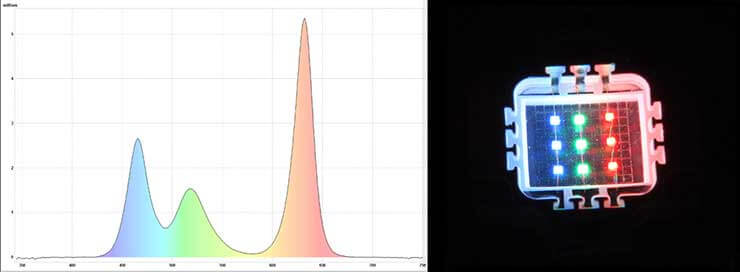
Spectrum analysis of an RGB LED matrix bulb calibrated at 3639 K
It isnot advisable to use this type of light source permanently, but only for festive atmospheres or chroma therapy sessions, or sporadically for a decorative atmosphere combined with another quality light source.
Compact fluorescent lamps (CFLs) also have light spectra with a few colour peaks.
The light output of CFL lamps often rises slowly after they are switched on and analysis of the light spectrum of this Full Spectrum bulb gives us a colour rendering index of 98.4 Ra, slightly higher than the values given on the box, but this stabilises at a lower value around thirty minutes later at 76.9 Ra.
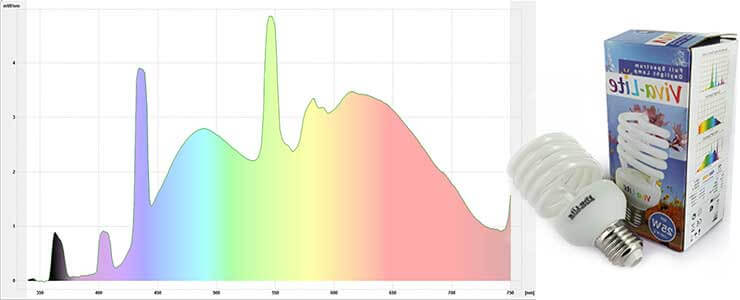
the same compact fluorescent lamp 30 minutes later
Lighting colour temperature
Lighting colour temperature plays an essential role in our homes, shops, offices and production workshops.
The choice of lighting colour in our homes will be dictated primarily by our personal taste. However, in living areas such as kitchens, bathrooms and offices, it's advisable to use white or warm white lighting shades, so that you can fully appreciate all the colours in your culinary preparations or carry out your work in the best possible conditions.
More amber shades are ideal for a living room or even a dining room, to create a warm atmosphere.
The choice of lighting colour in industrial environments: With reference to the colour of the sun at midday, it seems essential to us to use a white or light warm white lighting colour in a production workshop, laboratory and other workplaces subject to artificial lighting in order to guarantee sufficient illumination and to avoid discomfort, visual fatigue and accidents in the workplace. The colour temperature should be between 6000 and 3300 Kelvin.
Glare is a major factor in discomfort, so it is preferable to use indirect Strip LED lighting in coves or lighting sources with large emissive surfaces such as LED panels for low ceilings.
Good lighting power will ensure sufficient illumination for operations requiring the perception of detail.
The effect of the colour of wallcoverings, curtains and furniture has a huge influence on the final colour rendition of your lighting. This phenomenon is explained by the reflection coefficient of surfaces. For example, with white lighting, warm tones can be generated if the woodwork (furniture), curtains or wall paint is yellow-orange, and pale or greenish tones can be produced if they are incorrectly combined.
Kelvin colour temperature of different lamps and light sources.
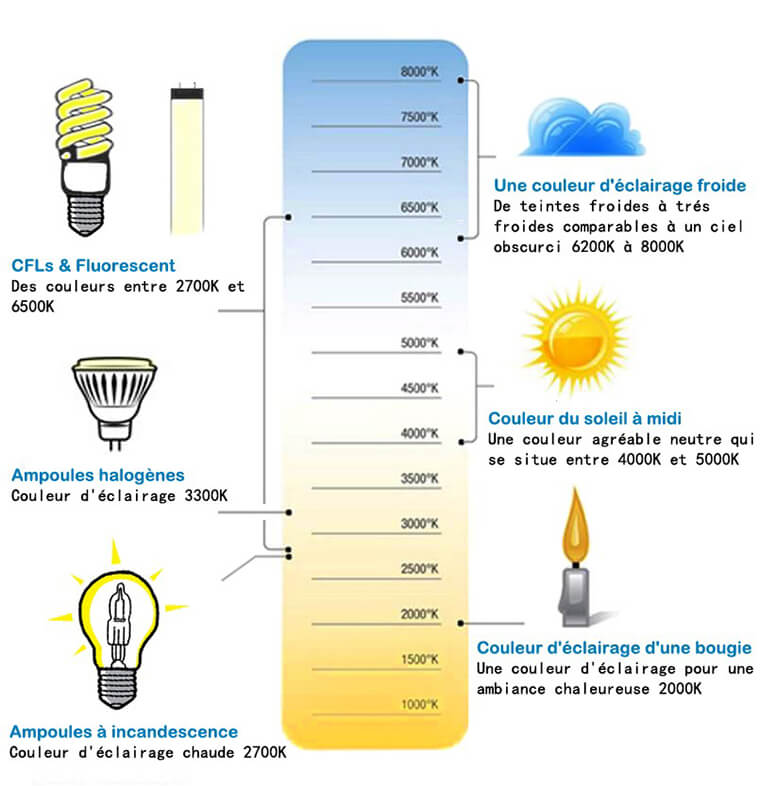
The danger of LED bulbs
On 25 October 2010, the French National Agency for Food, Environmental and Occupational Health and Safety (ANSES) published a report on light-emitting diodes (LEDs).
This report highlights two potential risks
- the risks of glare associated with the use of certain high luminance LED lamps (intensity of the light beam on a surface, in candela per m²) under certain conditions of use,
- the photobiological risks produced by certain LEDs whose light composition is said to involve a spectral imbalance in LEDs (high proportion of blue light in white LEDs).
These various tests were carried out to maximise the photobiological risks, i.e. by placing the eye of a potential user 20 cm from the light source (assessment conditions in standard EN 62 471).
we ask ourselves the following question: what would these risks be with a traditional halogen or incandescent bulb?
Common sense dictates that we should never look a light source in the face, whatever it may be.
Whenever possible, it's better to use indirect lighting, which is much more comfortable.
All our white light bulbs have a light colour of 5200 Kelvin. This colour temperature is commonly known as white or neutral white.
This report tells us that only bulbs containing a high proportion of blue light present a risk.
The lighting colour of this type of product would have a colour index greater than 6500 Kelvin - this colour temperature is generally referred to as cool white.
On the right in this photo is our 81 LED neutral white 5200 k bulb, as you can see there is a slight yellow tinge to our product. Unlike this cool white 80 LED bulb on the left of the photo.
This report highlights the risks associated with LED lighting. We believe that this risk only concerns low-end products using cool white LEDs, which have no place in a light bulb because there is no application requiring the use of this light colour.
The effect of this report will be to encourage consumers to switch to compact fluorescent technology
technology, which in our view is not the best alternative at the moment.
Lighting colour of our SMD technology LED bulbs
- Neutral white 5200 k (This is not a cool white, so there are no bluish tones)
- Light warm white 4600k (still a white but with a very slight shade of yellow/pink)
- Warm white 3300k (a warm white that is slightly less dark than a halogen bulb)
In this photo our 24 LED SMD bulb and a 50 watt halogen bulb


Choosing the right lighting colour:
The choice of lighting colour should above all remain a personal choice based on taste.
To achieve a neutral or warmer lighting atmosphere.
In some cases, the wrong choice of lighting colour can have a disturbing effect.
But here's some information to help you avoid mistakes.
Day white lighting colour
This colour is widely used by professionals for window and shop lighting, and is a very modern light.
Gone is the yellowish look of halogen.
This white lighting colour does not exist in halogen bulbs and is one of the strong points of LED technology.
White lighting is not recommended for rooms or wall and floor coverings that are already white, such as certain bathrooms or kitchens (neon effect, milky veil over the head; pale atmosphere).
In this case, choose a warmer lighting colour.
We have developed a range of bulbs with an intermediate light colour that we call Warm White Light.
This is still white but with a slight yellow/pink tinge.
(Available only for SMD technology bulbs with GU10 and MR16 bases)
Warm white:
This is the light colour closest to that of halogen bulbs. This amber-yellow colour is ideal for rooms with very light surfaces.
Conversely, warm white is not recommended for rooms with very dark surfaces, such as wood panelling, oak beams or very dark tiles.
This can lead to greenish effects.
Different colour temperatures :
Expressed in degrees Kelvin
Candle flame 1800 K
Sun at the horizon 2000 K
Sodium lamp 2200 K
Incandescent lamp 2400 to 2700 K
Warm white fluorescent lamp 2700 to 3000 K
Metal halide lamps 3000 to 4200 K
Halogen lamps 3000 to 3200 K
Neutral white fluorescent lamp 3900 to 4200 K
Sun at its zenith 5800 K
Daylight fluorescent lamps 5400 to 6100 K



